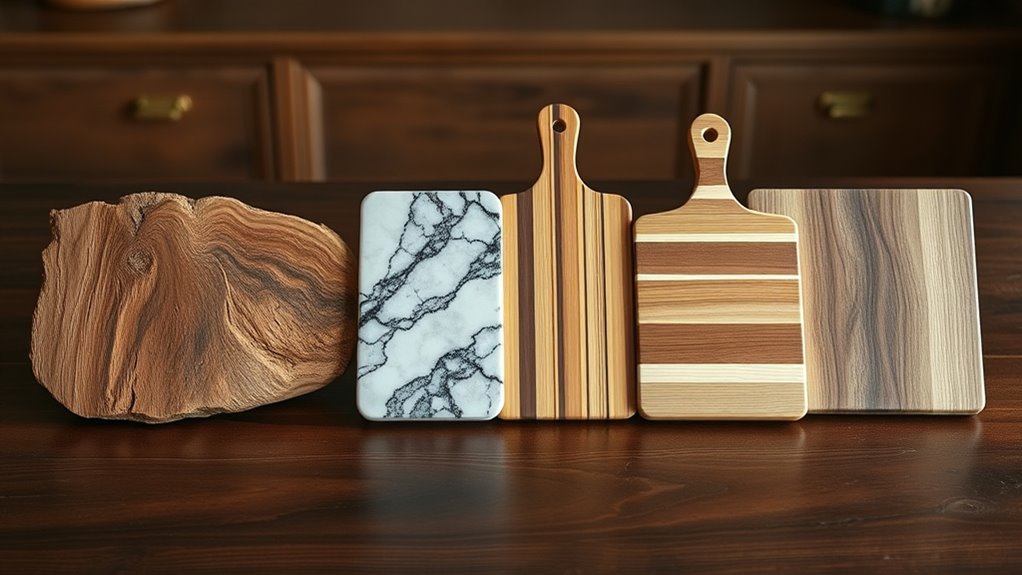Throughout history, chopping boards have evolved from primitive stone and wood surfaces used by ancient civilizations to modern tools made from plastics, glass, and composites. Early cultures chose materials based on availability, while medieval kitchens favored durable hardwoods. Innovations like antimicrobial surfaces, ergonomic designs, and cultural carvings have enhanced safety and artistry. Industrialization made boards more accessible and diverse. To discover how these changes continue shaping our kitchens today, keep exploring the fascinating history behind these everyday essentials.
Key Takeaways
- Early civilizations used natural materials like stones, logs, and clay tablets for basic food prep surfaces.
- Medieval Europe introduced lightweight, durable wooden boards made from hardwoods such as oak and maple.
- Modern innovations include plastics, glass, composites, and features like antimicrobial surfaces and ergonomic designs.
- Industrialization enabled mass production, reducing costs and increasing accessibility of diverse chopping board materials.
- Traditional artisanal craftsmanship and cultural motifs continue to influence decorative and ceremonial board designs.
Early Food Preparation Surfaces in Ancient Civilizations

Ancient civilizations relied on simple yet effective surfaces for food preparation, often using natural materials readily available to them. During early civilizations, surfaces like flat stones, logs, and clay tablets were common for chopping and processing food. Archaeological findings reveal that Egyptians around 3000 BC used alabaster stone boards for preparing meals. The Greeks and Romans favored granite and marble slabs, which provided durable cutting surfaces. These primitive boards, made from rocks and logs, were heavy and not portable, but they served essential roles in preparing bread, meat, and vegetables. These natural stone surfaces offered a sturdy, reliable platform for food preparation, helping early societies efficiently handle their daily culinary tasks. Their simplicity laid the groundwork for more advanced chopping board materials in later eras. Additionally, the use of natural materials like wood and stone in these early boards demonstrated an understanding of durability and functionality that influenced future kitchen tools. This early understanding of material durability and functionality contributed to the development of more sophisticated and specialized kitchen surfaces. Over time, innovations in material technology led to the development of lighter, more specialized kitchen surfaces, enhancing food prep efficiency. Furthermore, the introduction of protective and decorative coatings in later periods improved the longevity and hygiene of chopping boards.
Material Choices in Primitive and Classical Cultures
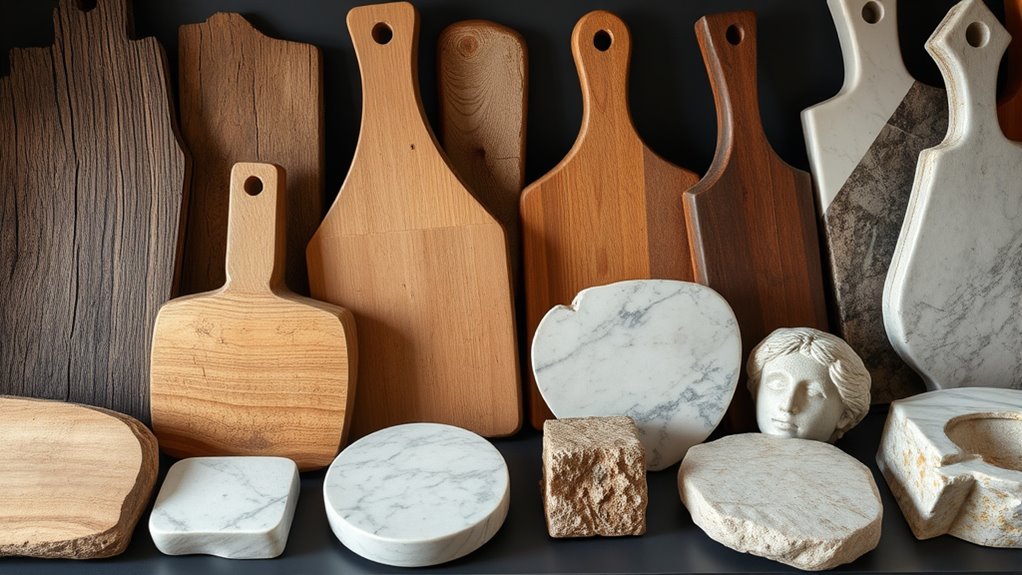
Primitive and classical cultures selected their food preparation surfaces based on the resources available in their environment. You’ll find that early civilizations used natural materials like flat stones, logs, and clay tablets for chopping and food prep. The ancient Egyptians, around 3000 BC, crafted alabaster stone boards, showing an early appreciation for durable, crafted surfaces. Greeks and Romans preferred materials like granite and marble, valuing longevity and hygiene. In medieval Europe, wooden boards made from hardwoods such as oak and maple became popular because they’re durable and gentle on knives. These cultural choices reflect how each society adapted to local resources, balancing practicality and available materials. Additionally, the understanding of material durability influenced the development of more specialized and sophisticated food prep surfaces over time. Recognizing the importance of material selection in culinary tools has also contributed to innovations in modern cutting surfaces. Furthermore, the choice of material type often depended on the specific food being prepared and the cultural significance attached to certain surfaces. As technology progressed, the development of refrigeration cycle concepts helped improve food preservation and safety, which indirectly impacted how food surfaces were maintained and utilized across different eras. Moreover, the evolution of cultural practices around food preparation reflects broader societal values and technological advancements.
The Rise of Wooden Chopping Boards in Medieval and Modern Kitchens
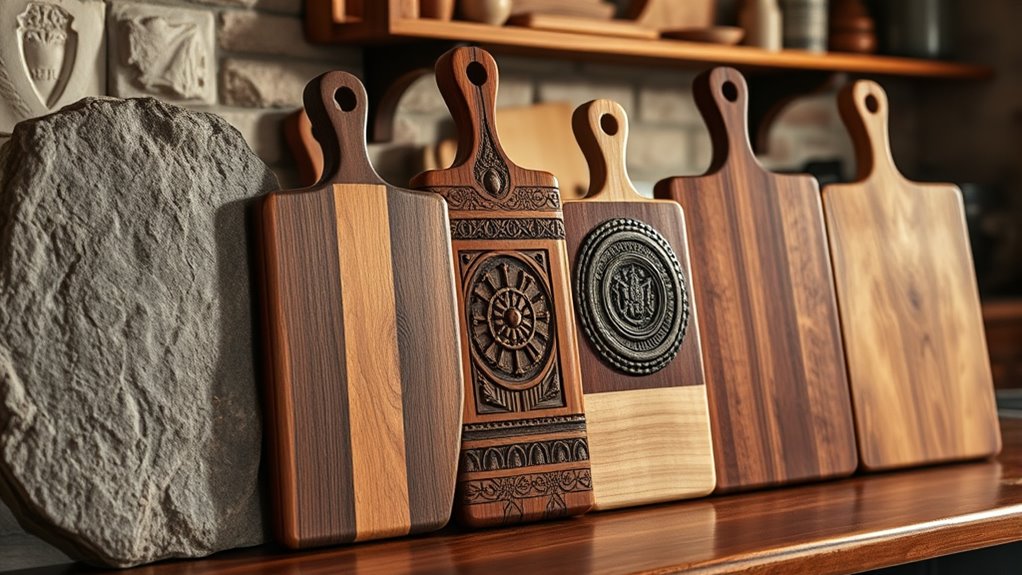
As kitchens evolved during the Middle Ages and into modern times, wooden chopping boards became the preferred choice for food preparation. Their durability and gentleness on knives made them ideal compared to stone surfaces, helping improve food safety. Craftsmanship improved, with hardwoods like oak, walnut, and maple favored for their resistance to knife marks and bacteria. In medieval kitchens, specialized wooden boards such as butchers’ blocks emerged, designed for heavy-duty meat processing. These robust boards not only enhanced hygiene but also increased efficiency in food prep. Proper board maintenance is essential to prolong their lifespan and ensure safety. Additionally, using antibacterial wood finishes can help further reduce bacterial growth on wooden surfaces. The development of hygienic cleaning methods over time has contributed significantly to maintaining the safety and longevity of wooden chopping boards. Today, wooden chopping boards remain popular in modern kitchens due to their aesthetic appeal, longevity, and natural antibacterial properties. Their evolution signifies a vital step in making kitchen environments safer and more functional through history.
Innovations in Design and Functionality Throughout History
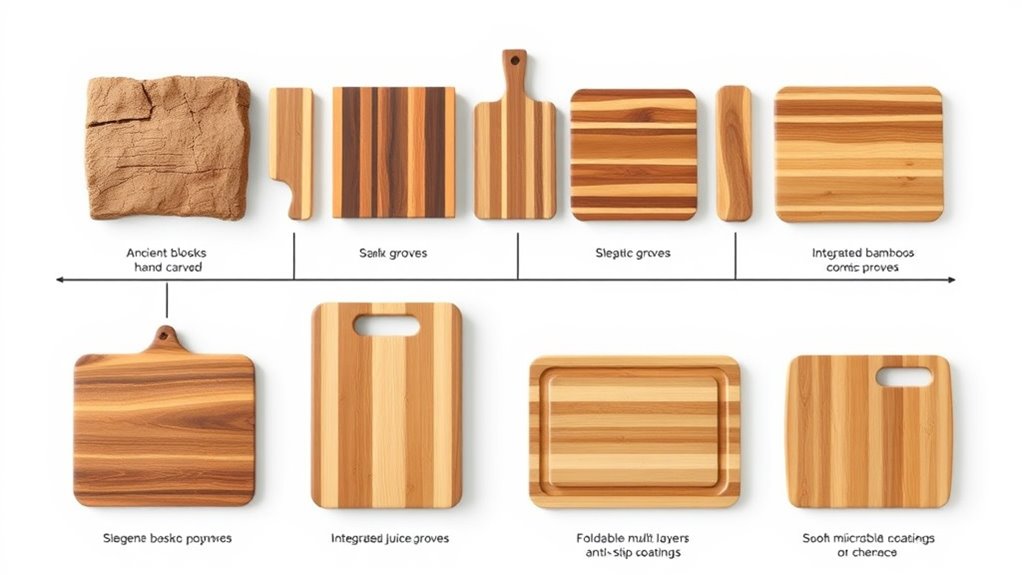
Throughout history, the design of chopping boards has continuously evolved to enhance safety, convenience, and efficiency in food preparation. Modern innovations have introduced features like handles, hanging holes, and non-slip feet, making them easier and safer to use. Juice grooves and raised edges help contain liquids, keeping your workspace cleaner. Materials advanced from primitive stones and rough wood to plastics, tempered glass, and composites, each offering specific benefits. Recent design evolution includes embedded antimicrobial surfaces to reduce bacteria and ergonomic shapes for comfort. Some boards now feature integrated knife sharpening slots, combining multiple functions. To visualize, here’s a quick overview:
| Feature | Material | Functionality |
|---|---|---|
| Handles & Holes | Wood, plastic, glass | Easy grip and storage |
| Juice Grooves | Wood, plastic, composite | Contain liquids, prevent messes |
| Antimicrobial Surfaces | Modern plastics, composites | Minimize bacteria, ensure safety |
In addition, ergonomic shapes have been developed to improve user comfort during prolonged use, and ongoing research into antimicrobial materials continues to enhance safety and hygiene in food preparation. Furthermore, innovative designs are now incorporating features that promote better airflow and drying, reducing mold and bacterial growth on the surface. Implementing sustainable manufacturing techniques can also contribute to a more eco-friendly approach to creating these essential kitchen tools.
The Impact of Industrialization on Production and Accessibility
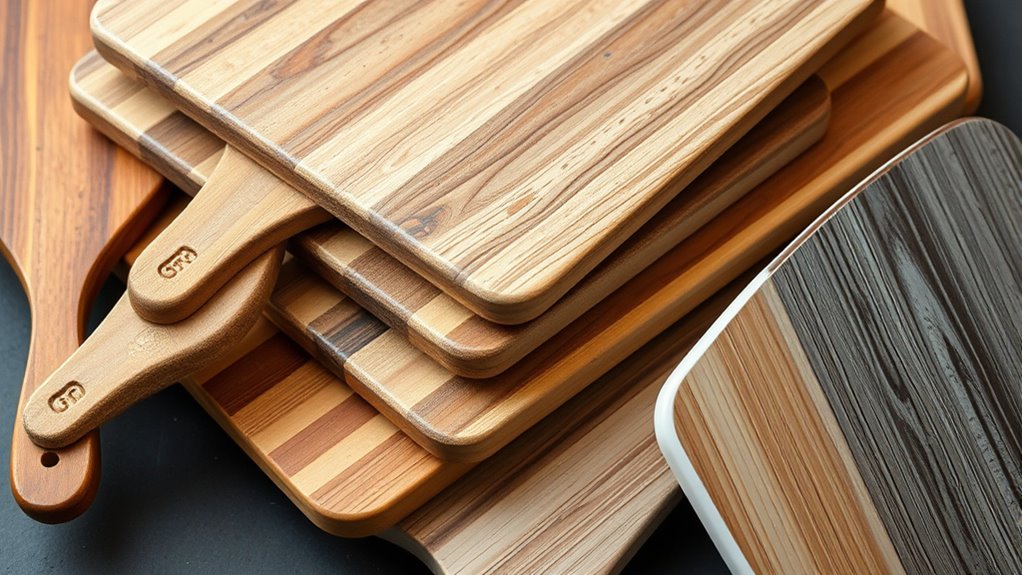
Industrialization revolutionized how chopping boards are made, enabling mass production that lowers costs and boosts availability. You now have access to a wide variety of materials, from plastics to composites, thanks to new manufacturing techniques. This shift has made durable, affordable options accessible to people worldwide, changing how kitchens are stocked. Additionally, advancements in material diversity have allowed for more specialized and sustainable options to meet different culinary needs. The proliferation of appliance labs has also contributed to improved quality control and innovation in the production process. Moreover, the development of organic and natural materials in manufacturing has further enhanced the sustainability and safety of these kitchen essentials. These innovations have also facilitated the integration of Mazda Tuning principles into manufacturing, promoting efficiency and customization in product development. Recognizing the importance of supporting sustainable practices, manufacturers are increasingly adopting eco-friendly processes to reduce environmental impact.
Mass Production Techniques
The advent of mass production techniques revolutionized the way chopping boards are manufactured, making them more efficient and widely accessible. By adopting advanced manufacturing processes like molding, extrusion, and compression, producers could quickly create plastic, glass, and composite boards at lower costs. These methods allowed for the use of inexpensive raw materials, reducing production expenses and expanding availability. Standardization became a key feature, ensuring each chopping board met consistent quality and design specifications. Automation and computer-aided design (CAD) further streamlined manufacturing, enabling large-scale, customized outputs with uniformity. As a result, chopping boards shifted from handcrafted items to essential kitchen tools accessible to consumers worldwide, supporting diverse culinary practices and making food preparation safer and more convenient for everyone. Additionally, integrating sound healing principles into manufacturing environments can improve worker well-being and productivity during mass production processes. The implementation of these technologies also facilitated quality control measures, ensuring durability and safety standards across large batches of products.
Material Diversity Expansion
Advancements in manufacturing technology have dramatically broadened the range of materials used for chopping boards, making them more accessible and suited to various needs. The industrial revolution’s machinery enabled mass production, lowering costs and increasing availability. The introduction of plastics in the early 20th century revolutionized materials, creating inexpensive, durable, and dishwasher-safe options. Techniques like molding, extrusion, and compression allowed manufacturers to produce materials like tempered glass, rubber, and recycled plastics efficiently. As a result, material diversity expanded beyond traditional wood and stone to include bamboo, composite plastics, and glass. This growth reflects technological progress and market demands, offering consumers a wider selection of chopping boards tailored to different preferences and uses.
- Use of synthetic plastics for affordability and durability
- Advanced manufacturing techniques for customization
- Growth of eco-friendly recycled plastics
- Expanded material choices for diverse needs
The Transition From Heavy Stone and Wood to Lightweight Materials
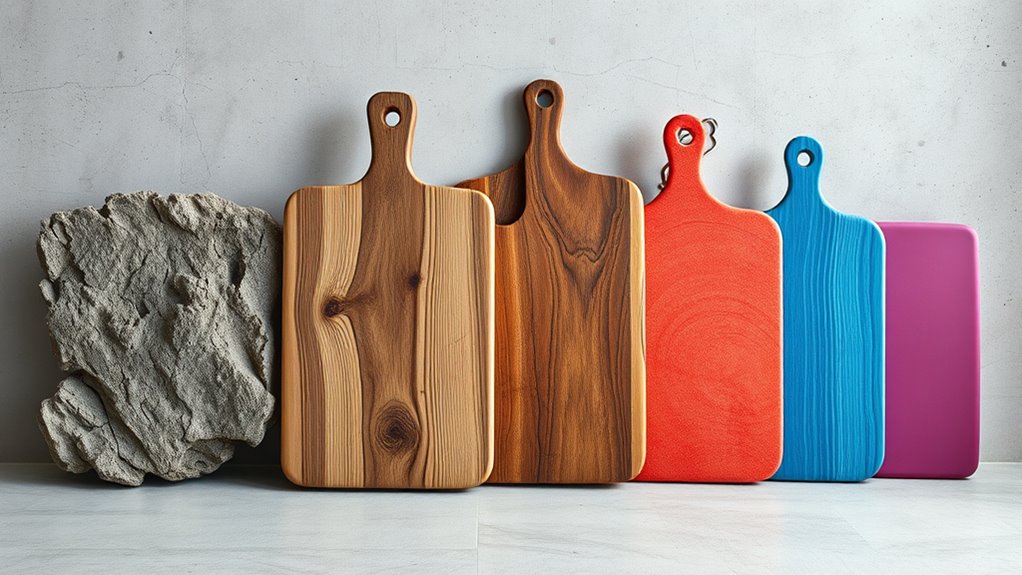
Initially, chopping surfaces were made from heavy stones and logs, which made them difficult to move and clean efficiently. The introduction of wooden cutting boards during the Middle Ages offered a lighter, more manageable option compared to stone and wood. Modern lightweight materials like plastic and bamboo further transformed the landscape, making chopping surfaces easier to handle and store. This shift improved kitchen ergonomics and allowed for greater flexibility in both home and professional settings. Here’s a quick comparison:
| Material | Weight | Benefits |
|---|---|---|
| Stone and wood | Heavy | Durable but cumbersome |
| Wooden boards | Moderate | Easier to clean and move |
| Plastic/bamboo | Lightweight | Highly portable and easy to store |
The Role of Hygiene and Food Safety in Material Selection
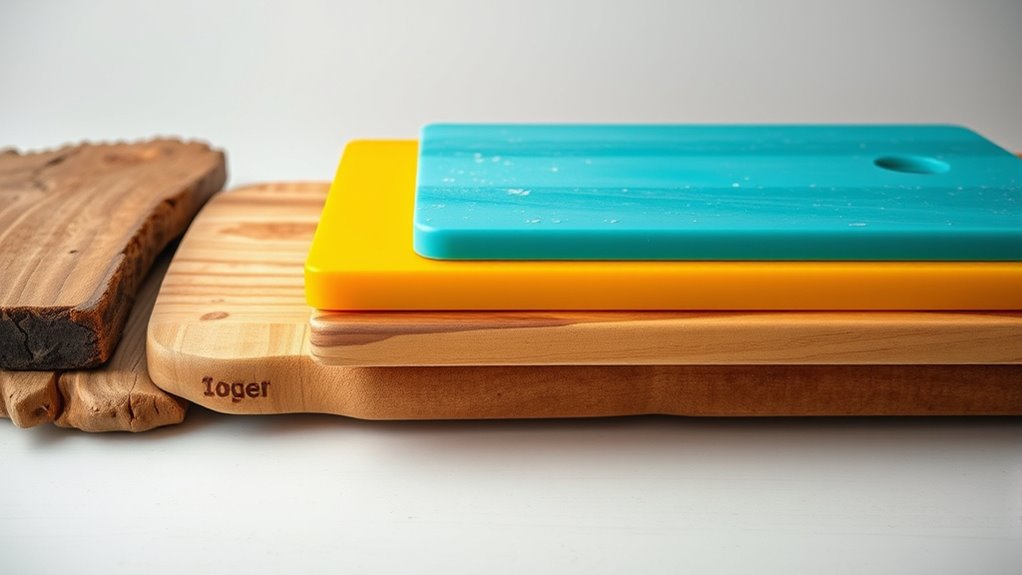
As kitchens moved toward lighter and more manageable materials, attention to hygiene and food safety became increasingly important. You need to choose cutting surfaces that minimize bacteria and cross-contamination risks. Wooden cutting boards, especially dense hardwoods like maple, harbor fewer bacteria because bacteria sink below the surface, making them easier to sanitize. Plastic cutting surfaces, however, often develop micro-scratches that trap bacteria, complicating cleaning. To guarantee food safety, it’s essential to properly clean and sanitize all cutting boards regularly. Consider these points:
- Dense hardwoods reduce bacterial survivability.
- Micro-scratches on plastics trap bacteria.
- Antimicrobial-treated plastics help prevent bacterial growth.
- Designated, color-coded boards prevent cross-contamination.
Choosing the right material plays a key role in maintaining hygiene and safeguarding food safety in your kitchen.
Modern Materials and Technological Advancements in Cutting Boards
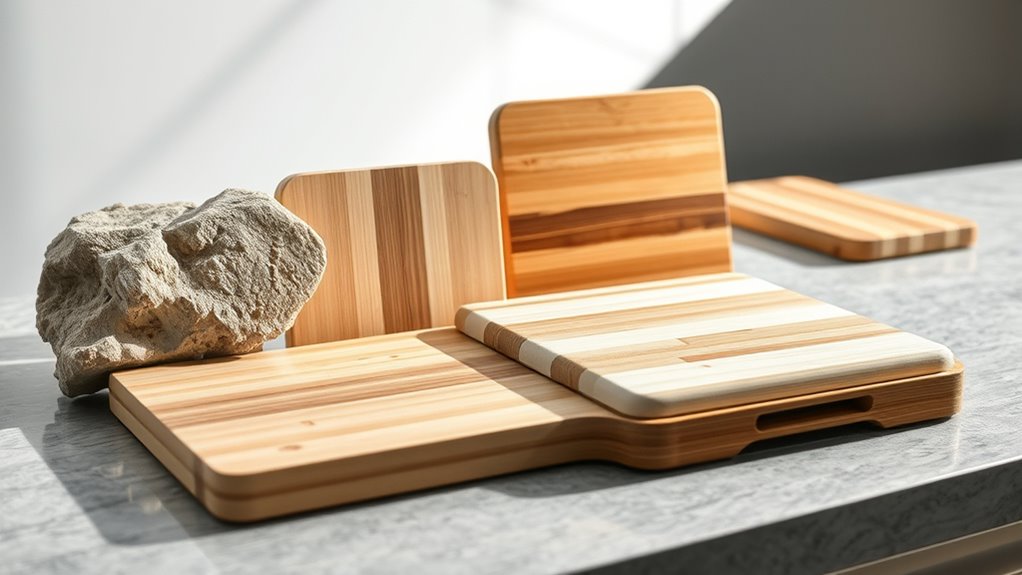
Modern materials and technological innovations have dramatically transformed cutting boards, offering more functional, hygienic, and convenient options for your kitchen. Plastic cutting boards, made from antimicrobial plastics like polyethylene and polypropylene, are now common due to modern manufacturing techniques such as molding and extrusion. These methods enable the production of diverse materials, including tempered glass, bamboo, and composite composites. Innovations include features like handles, hanging holes, non-slip feet, and juice grooves, boosting safety and usability. Advances in antimicrobial plastics reduce bacterial growth, improving hygiene. Additionally, smart cutting boards with onboard sensors and self-sanitizing surfaces represent cutting-edge progress in food safety and convenience.
| Material | Key Features | Benefits |
|---|---|---|
| Plastic (antimicrobial) | Dishwasher-safe, durable | Hygienic, easy maintenance |
| Tempered Glass | Heat-resistant, non-porous | Scratch-resistant |
| Bamboo | Eco-friendly, natural antibacterial | Lightweight, sustainable |
| Composite | Customizable, sturdy | Versatile and long-lasting |
| Smart Boards | Sensors, self-sanitizing | High-tech safety and hygiene |
Cultural Significance and Artistic Craftsmanship of Traditional Boards
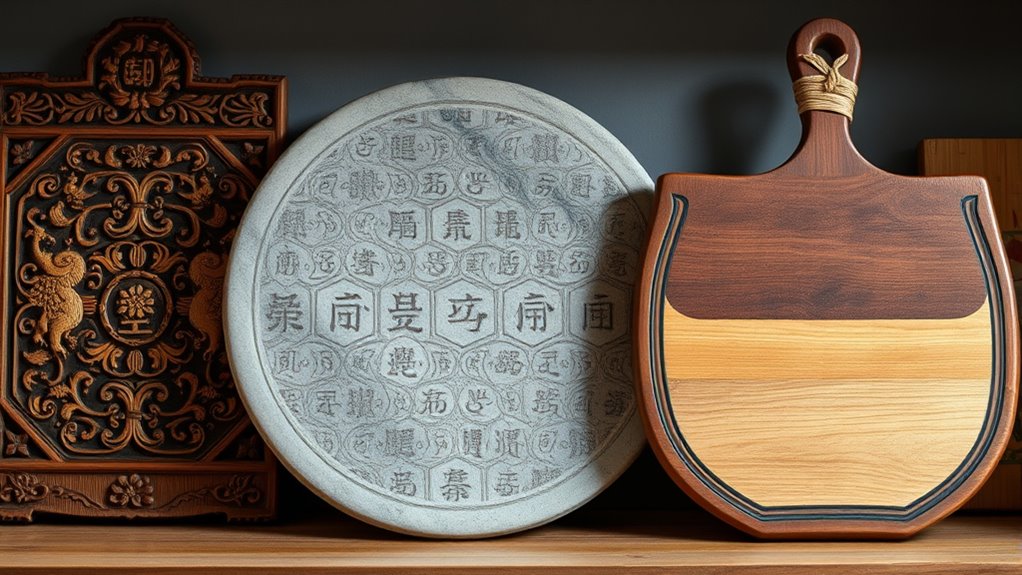
Traditional chopping boards often showcase intricate carvings, inlays, or painted motifs that highlight regional artistry. These handcrafted pieces serve as symbols of cultural heritage, passed down through generations. Their design and craftsmanship reflect local techniques and cultural identity, making them more than just kitchen tools.
Artistic Design Traditions
Artistic design traditions imbue traditional chopping boards with cultural meaning and craftsmanship that go beyond simple utility. You’ll notice how wooden boards feature intricate carvings, inlays, or painted motifs reflecting regional artistic styles. These ornamental details often incorporate symbolism or motifs representing heritage, spirituality, or social status, elevating the board’s significance. Artisans use natural dyes, detailed carving, and wood inlay techniques to create unique pieces, often for special occasions or as artisan crafts. The craftsmanship involved guarantees each board is a work of art, blending functionality with cultural expression. These boards serve as ceremonial objects, heirlooms, or symbols of artisanal pride, showcasing the rich tradition of decorative woodworking. Their artistic design connects you to a centuries-old legacy of cultural storytelling.
Cultural Heritage Significance
Have you ever noticed how some chopping boards carry more than just culinary function? These boards embody cultural heritage through their artisanal craftsmanship, reflecting regional styles and traditions. Crafted from traditional materials like specific woods, they often feature design motifs that symbolize local customs, spiritual beliefs, or social status. Handcrafted boards from indigenous communities incorporate symbols and patterns passed down through generations, turning them into cultural artifacts. Their intricate carvings and inlays showcase the artistry and skill of artisans, elevating these tools beyond mere kitchen utensils. These boards preserve historical culinary practices and serve as a visual expression of regional identity. By appreciating their craftsmanship and design motifs, you connect with a rich cultural legacy that celebrates tradition, artistry, and cultural diversity.
Handcrafted Craftsmanship Techniques
Handcrafted craftsmanship techniques give traditional chopping boards their unique character and cultural significance. Skilled artisans use methods like hand carving, steaming, and applying natural oils to enhance both durability and beauty. These techniques often feature intricate carvings, decorative edges, and inlays that reflect regional artistry and symbolism. Wood craftsmanship is carefully executed, with attention to grain orientation and jointing to ensure stability and longevity. The process also involves detailed sanding, polishing, and sealing, which showcase the artisan’s skill while maintaining the board’s functional integrity. Many cultures, including Irish, Scandinavian, and Japanese traditions, emphasize these craftsmanship techniques, turning each board into a piece of artistic expression and cultural heritage.
- Hand carving for intricate designs
- Application of natural oils for protection
- Skillful sanding for smooth finishes
- Attention to regional woodworking traditions
Future Directions in Design, Sustainability, and Food Safety
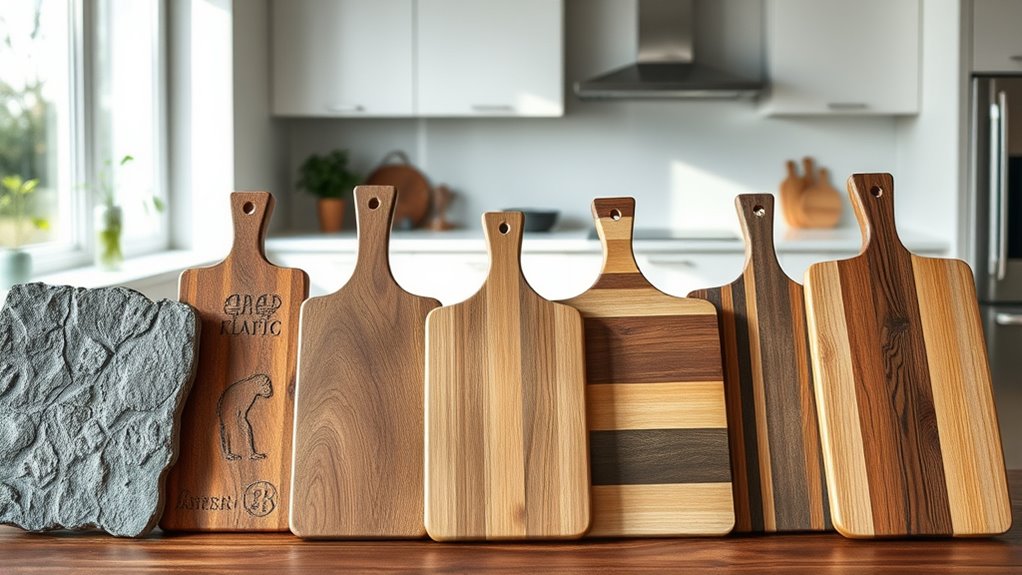
Looking ahead, the future of chopping board design is focused on enhancing food safety, sustainability, and user convenience. You’ll see innovative materials like antimicrobial, self-sanitizing surfaces that make cleaning easier and reduce bacteria. Waterproof, hydrophobic surfaces will prevent moisture buildup, improving hygiene. Sensors embedded in the boards will monitor bacterial levels or alert you when cleaning is needed, boosting food safety. Sustainability takes center stage with recycled plastics, bamboo composites, and plant-based bioplastics, reducing environmental impact. Ergonomic and modular designs will optimize comfort and storage, making your kitchen more functional. Industry trends emphasize eco-friendly manufacturing and biodegradable products, aligning with environmental goals. These advancements aim to create safer, greener, and more efficient chopping boards for modern kitchens.
Frequently Asked Questions
What Are the 6 Different Chopping Boards?
You’re asking about the six different chopping boards. You’ll find plastic boards, which are lightweight, inexpensive, and come in colors for easy food separation. Wooden boards made from hardwoods like maple or walnut are durable and naturally antibacterial. Glass boards are stain-resistant and easy to clean but can dull your knives. Bamboo boards are eco-friendly, hard, and antimicrobial. Rubber boards are flexible, resistant to knife marks, and slip-resistant.
What Is the History of the Chopping Block?
Imagine preparing a meal on a sturdy wooden chopping block, just like ancient cooks did. You’re curious about its history, right? Chopping blocks date back to civilizations like Egypt and Greece, made from stone or wood. Over centuries, designs improved with handles and non-slip bases. Today, they blend craftsmanship and durability, connecting you to a culinary legacy that spans thousands of years, enriching your cooking experience.
Who Invented the First Cutting Board?
You might wonder who invented the first cutting board, but there’s no specific person credited with its creation. Early civilizations like Egypt, Mesopotamia, Greece, and Rome used natural materials such as stone, wood, and metal for food preparation surfaces. Over time, artisans crafted dedicated, flat surfaces, evolving into the modern cutting boards we use today. It was a gradual development rather than the work of a single inventor.
When Was the First Use of Wooden Chopping Board?
You might find it astonishing, but the first recorded use of wooden chopping boards dates back to the Middle Ages, around the 12th to 15th centuries. During this time, craftsmen crafted sturdy, handcrafted boards from hardwoods like oak and maple, revolutionizing food prep. These wooden marvels replaced stone surfaces, making chopping easier and knife blades happier. Their rise marked a turning point in culinary history, blending practicality with craftsmanship.
Conclusion
As you trace the evolution of chopping boards, you’ll see how each era shaped your culinary journey— from ancient stone slabs to sleek, high-tech surfaces. Just like discovering a hidden treasure in a vintage video game, modern materials blend tradition with innovation to keep your food safe and stylish. Embrace the journey, knowing that your cutting board isn’t just a tool but a reflection of history, culture, and the future—ready for your next culinary quest.
